 W
WAmphiaspididae is a family of extinct amphiaspidid heterostracan agnathans whose fossils are restricted to Lower Devonian marine strata of Siberia near the Taimyr Peninsula. In life, the amphiaspidids of Amphiaspididae are thought to be benthic animals that lived most of their lives mostly buried in the sediment of a series of hypersaline lagoons. Amphiaspids are easily distinguished from other heterostracans in that all of the plates of the cephalothorax armor are fused into a single, muff-like unit, so that the forebody of the living animal would have looked like a potpie with a pair of small, or degenerated eyes, with each flanked by a preorbital opening, and a simple, slit-like mouth.
 W
WAmphiaspidoidei is a taxon of extinct amphiaspidid heterostracan agnathans whose fossils are restricted to Lower Devonian marine strata of Siberia near the Taimyr Peninsula. In life, the amphiaspidids of Amphiaspidoidei are thought to be benthic animals that lived most of their lives mostly buried in the sediment of a series of hypersaline lagoons. Amphiaspids are easily distinguished from other heterostracans in that all of the plates of the cephalothorax armor are fused into a single, muff-like unit, so that the forebody of the living animal would have looked like a potpie or a hot waterbottle with a pair of small, or degenerated eyes flanked by preorbital openings, a pair of branchial openings for exhaling, and a simple, slit-like mouth.
 W
WAmphiaspis argo is the type species of the cyathaspidid taxon Amphiaspidida, and of the family Amphiaspididae. Its fossils are restricted to early Emsian-aged marine strata of the Taimyr Peninsula, Early Devonian Siberia. A. argo, as with all other amphiaspidids, is thought to have been a benthic filter feeder that lived on top of, or buried just below the surface of the substrate of hypersaline lagoon-bottoms.
 W
WAmphoraspis stellata is an amphiaspidid heterostracan in the family Amphiaspididae. Its fossils are restricted to early Devonian-aged marine strata of the Taimyr Peninsula, Siberia. A. stellata, as with all other amphiaspidids, is thought to have been a benthic filter feeder that lived on top of, or buried just below the surface of the substrate of hypersaline lagoon-bottoms.
 W
WAriaspidae is a family of extinct cyathaspidiform heterostracan agnathans in the suborder Cyathaspidida.
 W
WAteleaspis is an extinct genus of primitive ostracoderm fish that lived in the Early Silurian to Early Devonian periods. Like other ostracoderms, Ateleaspis had a head shield similar to that of Cephalaspis. Species from Silurian period were found in Norway and Scotland, but now has been found also in Siberia from Early Devonian period.
 W
WBoreaspis is an extinct genus of osteostracan agnathan vertebrate that lived in the Devonian period.
 W
WCardipeltis is an extinct genus of heterostracan agnathan from marine strata of early Devonian of Utah, and Wyoming. Species of Cardipeltis superficially resemble those of cyathaspids in having a flattened body and indistinct head covered by a large, broad, guitar pick or heart-shaped dorsal shield, and a long, scaly tail. Unlike cyathaspids, which all have a single ventral plate, however, the ventral shield of Cardipeltis is a mosaic composed of large scales.
 W
WCtenaspidae is a family of extinct cyathaspidiform heterostracan agnathans in the suborder Cyathaspidida.
 W
WCtenaspis is an extinct genus of heterostracan cyathaspid agnathans from the early Devonian of Canada.
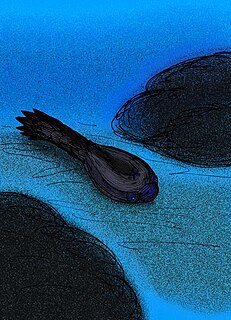 W
WCyathaspidida is a taxon of extinct cyathaspidiform heterostracan agnathans whose fossils are found in Silurian to Lower Devonian marine strata of Europe and North America. In life, they are thought to be benthic animals that lived most of their lives either mostly buried in or resting directly on top of the substrate.
 W
WDoryaspis is an extinct genus of primitive jawless fish that lived in the Devonian period. Fossils have been discovered in Spitsbergen.
 W
WDrepanaspis is an extinct genus of primitive jawless fish from Early Devonian marine strata of Europe. D. gemuendenensis, of the Hunsrück lagerstätte is the best known, and most thoroughly studied species, as it is known from several articulated specimens.
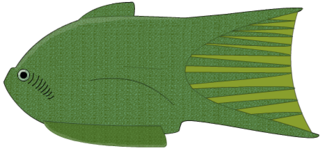 W
WDrepanolepis is an extinct genus of thelodont which lived in Canada during the Early Devonian period.
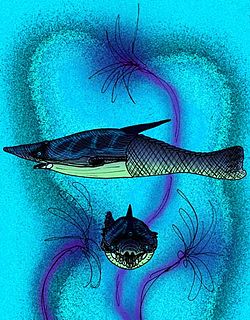 W
WErrivaspis is an extinct genus of pteraspid heterostracan agnathan vertebrate known from fossils at the Wayne Hereford Quarry, of Early Devonian England, and of Podolia, Early Devonian Ukraine. It was originally described by Dr. Errol Ivor White as one of five form-variants of Pteraspis rostrata, i.e., "Pteraspis rostrata var. waynesis. In 1984, Alain Blieck moved var. waynesis into its own genus, Errivaspis, which he named after Dr. White. Other later researchers would then mistakenly assume that Blieck synonymized the entire genus of Pteraspis into Errivaspis.
 W
WFurcacaudiformes is an extinct order of jawless fish in the class Thelodonti.
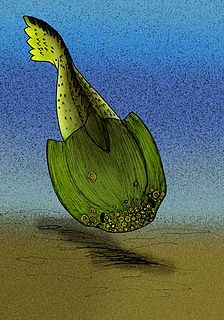 W
WGabreyaspididae is a family of extinct amphiaspidid heterostracan agnathans whose fossils are restricted to Lower Devonian marine strata of Siberia near the Taimyr Peninsula. In life, all amphiaspidids are thought to be benthic animals that lived most of their lives mostly buried in the sediment of a series of hypersaline lagoons. Amphiaspids are easily distinguished from other heterostracans in that all of the plates of the cephalothoracic armor are fused into a single, muff-like unit, so that the forebody of the living animal would have looked, in the case of gabreyaspidids, vaguely like a horseshoe crab with a pair of small, or degenerated eyes, with each flanked by a preorbital opening, and a simple, slit-like mouth positioned slightly ventrally.
 W
WHemicyclaspis is an extinct genus of primitive jawless fish, closely related to Cephalaspis, that lived in the Devonian period in what is now Europe and North America. A typical cephalaspid, Hemicyclaspis had a heavily armored, shovel-shaped headshield. It is thought to have been a better swimmer than most of its relatives because of its powerful tail, stabilizing dorsal fin and the keel-shaped hydrodynamic edges of its head shield. Hemicyclaspis probably foraged the ocean floor for food.
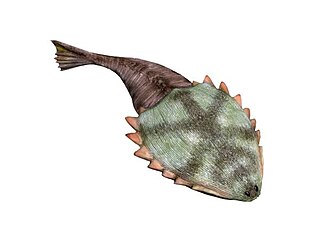 W
WHibernaspidoidei is a taxon of extinct amphiaspidid heterostracan agnathans whose fossils are restricted to Lower Devonian marine strata of Siberia near the Taimyr Peninsula. In life, hibernaspid amphiaspidids are thought to be benthic animals that lived most of their lives mostly buried in the sediment of a series of hypersaline lagoons. All amphiaspids are easily distinguished from other heterostracans in that all of the plates of the cephalothorax armor are fused into a single, muff-like unit, so that the forebody of the living animal would have looked like a potpie or a hot waterbottle with a pair of small, or degenerated eyes, a pair of branchial openings for exhaling, and, in the case of hibernaspids, a simple, slit-like mouth at the anterior end of a tube-like head.
 W
WHibernaspis is a genus of extinct amphiaspidid heterostracan agnathans whose fossils are restricted to Lower Devonian marine strata of Siberia near the Taimyr Peninsula. In life, species of Hibernaspis were thought to be benthic animals that lived most of their lives mostly buried in the sediment of a series of hypersaline lagoons. All amphiaspids are easily distinguished from other heterostracans in that all of the plates of the cephalothorax armor are fused into a single, muff-like unit, so that, in the case of Hibernaspis, the forebody of the living animal would have looked like a large guitar pic with serrated edges, with a pair of tiny, degenerated eyes, a pair of branchial openings for exhaling, and a simple, slit-like mouth at the anterior end.
 W
WJanaspis is an extinct genus of osteostracan, that lived in the early Devonian period in Britain. It is characterised by a number of features of its armoured headshield, including the presence of raised rims around its eyes, the shape of its lateral and median fields, its prominent dorsal spine, fairly long cornual processes and ornamentation. Janaspis was fairly small compared with other osteostracans, with a headshield measuring less than 60mm.
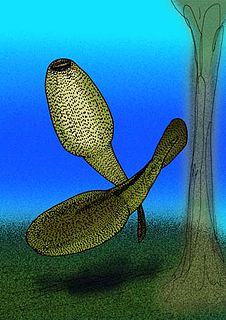 W
WLepidaspis serrata is an extinct heterostracan jawless fish from Early Devonian Canada. Its scientific name refers to the fact that the armor is composed of hundreds of tiny scales with serrated edges.
 W
WNeeyambaspis enigmatica is the lesser known of the two species of pituriaspid agnathans. The species lived in estuaries during the Middle Devonian, in what is now the Georgina Basin of Western Queensland, Australia.
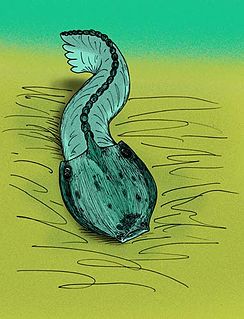 W
WOlbiaspididae is a family of extinct amphiaspidid heterostracan agnathans whose fossils are restricted to Lower Devonian marine strata of Siberia near the Taimyr Peninsula. In life, all amphiaspidids are thought to be benthic animals that lived most of their lives mostly buried in the sediment of a series of hypersaline lagoons. Amphiaspids are easily distinguished from other heterostracans in that all of the plates of the cephalothoracic armor are fused into a single, muff-like unit, so that the forebody of the living animal would have looked, in the case of olbiaspidids, vaguely like a hot water bottle with a pair of small, or degenerated eyes, with each flanked by a preorbital opening, and a simple, slit-like mouth positioned at the anteriormost portion of the cephalothoracic armor.
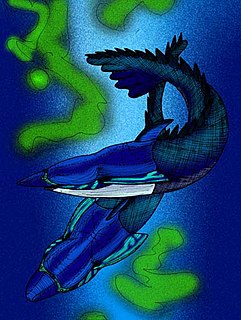 W
WPanamintaspis snowi is an extinct species of pteraspidid heterostracan agnathan which existed during the early Middle Devonian period of Death Valley, California. Fossils are found in Late Emsian-aged marine strata of the Lost Burro Formation. P. snowi strongly resembles Pteraspis, though while it was originally described as a member of the same family, Pteraspididae, a recent phylogenetic reassessment of the order Pteraspidiformes places P. snowi within the paraphyletic family "Protopeteraspidae," as the sister taxon of the suborder Pteraspidoidei.
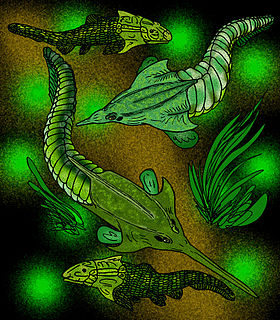 W
WThe Pituriaspida are a small group of extinct armored jawless fishes with tremendous nose-like rostrums, which lived in the marine, deltaic environments of Middle Devonian Australia. They are known only by two species, Pituriaspis doylei and Neeyambaspis enigmatica found in a single sandstone location of the Georgina Basin, in Western Queensland, Australia.
 W
WPituriaspis doylei (Doyle's pituri shield) was one of two known species of jawless fish belonging to the Class Pituriaspida, and is the better known of the two. The species lived in estuaries during the Givetian epoch of the Middle Devonian, 390 million years ago in what is now the Georgina Basin of Western Queensland, Australia.
 W
WProtopteraspididae is an extinct family of pteraspidid heterostracan agnathans. Fossils of the various genera are found in early Devonian-aged marine strata. Protopteraspidids were once thought to represent a taxon of basal pteraspidids but recent evaluations demonstrate that Protopteraspididae is a paraphyletic group of various transitional forms representing a gradual transition between the more advanced Pteraspoidei, and the anchipteraspidids and the Psammosteids.
 W
WProtopteraspis is an extinct genus of pteraspidid heterostracan agnathan with fossils known from Lower Devonian marine strata in Western Europe. The animal's somewhat flat build has led some to believe that it was a bottom dweller, living in freshwater areas. It has been described as "somewhat unspecialized". Its snout was round and narrow, shorter than that of its immediate relatives. Protopteraspis also did not possess the cornua (horns) found on the headshields of other pterapsids; rather, it had "small points" behind the gill opening. It did possess a "medium-sized" dorsal spine. Plates covering the headshield had ridges of dentine. It is theorized that the headshield formed in youth and that it grew via growth of the plates, which fused in adulthood. The scales of the animal were "small and diamond shaped".
 W
WPsammmosteida also called as Psammosteoidei is a suborder of pteraspidid heterostracan agnathans. The psammosteids had broad, flattened bodies, suggesting a predominantly benthic habit. The earliest unequivocal psammosteid is Drepanaspis of Early Devonian Germany, which is either included in the family Psammosteidae, or placed within its own family, Drepanaspididae. If the late Silurian/Early Devonian Weigeltaspis is a psammosteid, as opposed to being a traquairaspid, then that genus, instead, would be the oldest psammosteid. However, its placement within Heterostraci remains a matter of debate. Other notable psammosteids include Psammosteus, and Obruchevia, two genera of enormous species with dorsal shields around one meter in diameter. The Psammosteids were the only heterostracans to survive to the end of the Devonian, where they finally perish during the Hangenberg event.
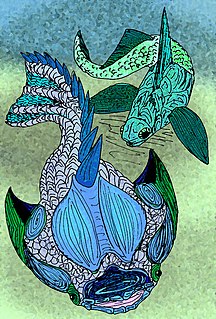 W
WPsammosteidae is an extinct family of flattened, benthic heterostracan vertebrates that lived in marine and estuary environments in Europe, Russia & North America. They arose during the Early Devonian, with the first known genus, Drepanaspis from the Hunsrück lagerstätte. The Psammosteids were the only heterostracans that survived the Upper Frasnian extinction event during the Late Devonian, dying out in the extinction event at the very end of the Devonian.
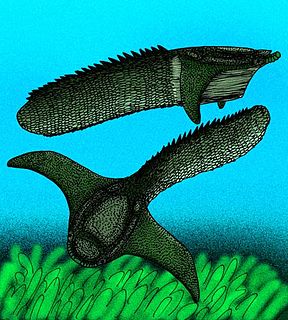 W
WPycnosteus is an extinct genus of jawless fish from the Devonian. It is thought to have cruised through vegetation, eating small invertebrates which it knocked loose .
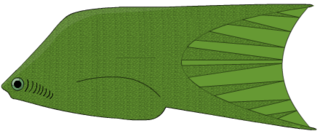 W
WSphenonectris is an extinct genus of thelodont, which lived in Canada during the Early Devonian period.
 W
WZenaspis is an extinct genus of jawless fish which existed during the early Devonian period. Due to it being jawless, Zenaspis was probably a bottom feeder. The fish was around 10 inches (25 cm) in length.